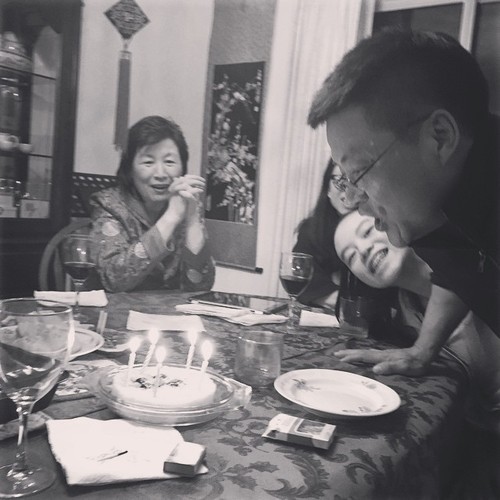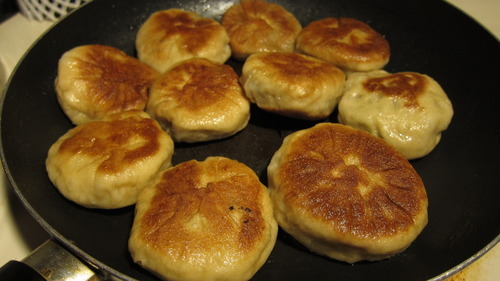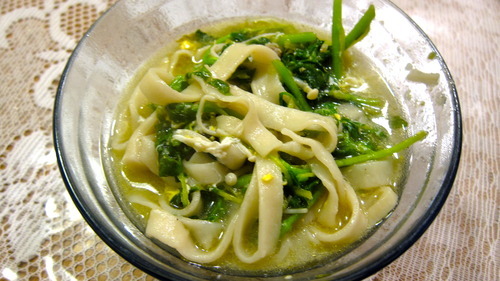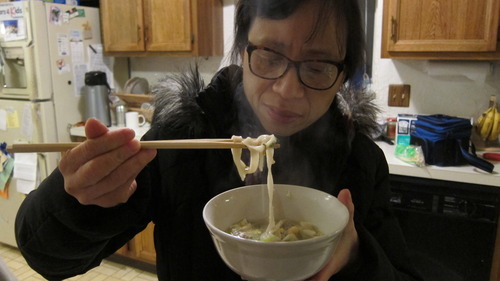Text
Mom’s cooking: by me

Last week, my ASA “dad” Matt suggested organizing a home-cooked family dinner. Since the end of the semester has been relatively relaxed for me and considering how stressed all my peers seemed, I also wanted to help out by bringing them a bit of comfort through food. I ended up dictating most of the menu to be close to a typical meal at home, and it was exactly what I needed and I think what my friends needed: the perfect combination of vegetables, meat, soup, rice, and company. As I cooked with Matt, we reminisced about the familiar smells and sounds of the kitchens of our childhood: the fragrance of garlic and the crackle of wet greens hitting hot oil. I’m so glad that after all these years I was able to pick up some things from Mom, after all. From deciding how many of each ingredient to buy, to deciding how much of what seasoning to use, how long to cook each dish, I understand intuitively what the answers were.
As I stood in the kitchen cutting chicken into bits, my “family” was sitting in the common room, working on their homework. When each dish would come out of the pan and onto the dining table, my friends would come and try a few pieces while I returned to the kitchen, just like Rui, Dad, and I would when Mom cooked for us.
RECIPES: (starting at top center, working clockwise)
Pickled mustard greens & pork
This dish was devised by Matt, whose family’s culinary background is based in traditions surrounding Hong Kong / Southern China. Mustard greens (芥菜 jie cai) normally taste kind of bitter and taste really good in soups. Pickled, the original defining smell/taste is maintained but combined with a salty umami flavor. The pickled kind is packaged while still semi-soaked in its pickling juice. Soak the pickled mustard greens for at least an hour. Matt says that he usually soaks the mustard greens for longer, but because we had hungry people to feed we did the bare minimum. This meant that the dish ended up being saltier than I would prefer, but everyone else didn’t seem to mind. Another thing that we think may be specific to Hong Kong cuisine is the tendency to coat meat in cornstarch to tenderize it. Cut pork into strips and marinate in soy sauce and cornstarch mixture for at least half an hour. We used about half a pound of pork for an entire package of pickled mustard greens. Heat oil, add garlic, stir-fry pork until lightly browned, then add pickled mustard greens. This dish ended up being the saltiest dish of the four, so it was a good balance to my three dishes.
Garlic bokchoy
A true classic. Green leafy vegetables stir-fried with garlic is a staple to most everyday dinner tables. Make sure you take apart each individual leaf and wash out the dirt! This process can be applied to the cooking of any green leafy vegetable, but in this case we used what we call (青菜 qing cai): Heat oil, add garlic, stir until fragrant, add washed greens, add salt and pepper to taste. The end result is a savory but clean plate of greens! How long you cook your greens should vary on your preference of softness/crunchiness. Typically leafy greens should retain some crunchiness without being raw.
Two-pepper chicken
My take on a Sichuan dish called three-pepper chicken, which uses long hot peppers, bell peppers, and sichuan peppercorn. I don’t love the sensation of numbing sichuan peppercorn, so I omitted it. I love the balance between sweet bell peppers and spicy long hot peppers, but since the supermarket didn’t have any long hot, I substituted in two jalapeños. I also prefer using chicken thigh, but the store didn’t have any chicken thigh that looked good, so I substituted in fresher looking chicken drumsticks from which I cut all the meat off the bone. Regardless of what cut of chicken you have, cut chicken into bite size pieces. Heat oil, add garlic, stir-fry chicken. When stir-frying meat, the standard procedure is add some soy sauce / let that reduce / add some cooking wine / let that reduce. I didn’t have cooking wine but it turned out fine! For seasoning, I added a good scoop of shacha sauce (沙茶酱 sa cha jiang) which we typically only use as a hotpot condiment at home, but it was perfect as a coking condiment in this dish. The sauce is made of bits of different seafood and sesame oil and the flavor complimented the chicken well. While chicken in cooking, cut bell peppers into bite-size chunks and dice jalapeños. To control how spicy this dish becomes, you need to pay attention to how much of the jalapeños seeds are used. For my spice tolerance, I removed half of the seeds from each of the jalapeños, which you can do by cutting the pepper in the middle from stem to tip and scooping the seeds out. Add peppers to cooked chicken, add salt/pepper/soy sauce to taste. Optional last step: turn off heat and add chopped green onions for garnish and a little extra flavor.
Tomato egg-drop soup
This is such an easy soup to make, and is a go-to when time-crunched and you don’t feel like making a bone based soup that would take longer. A hack that my mom always uses is to flavor the soup with the pickled mustard green used to flavor Szechuan style spicy/sour fish stew (酸菜鱼 suan cai yv). I actually never realized that these pickled greens were the same as the ones that Matt used in the first dish, because the ones he used in his stir-fry were mostly stem while the once used in these condiment packages are mostly leaf. You learn something new everyday! First, cut tomatoes into larger chunks and lightly stir fry in some oil. Add water and bring to light boil. We left the soup like this while cooking the rest of the meal so when we came back to it the tomatoes were definitely nice and soft, but it shouldn’t take more than a few minutes on a high boil. At this point, add the spicy/sour fish condiments aka pickled mustard greens and salt. Definitely don’t add the entire package, but incrementally add so that it doesn’t end up making your soup overwhelmingly sour/spicy. To create the egg drop texture, beat eggs in a bowl and add incrementally to boiling soup while stirring the pot. The soup is now done, but for extra flavor, chop up a bunch of green onions and cilantro and dump it all on top, as pictured.
Don’t forget to pair with white rice!
8 notes
·
View notes
Text
Seeing as the last post included a picture of me in braces, it’s safe to say we have neglected to keep this blog going. A lot has happened: Rae got engaged, still powering through med school, I graduated high school, and I’m a first-year at Duke! Sadly, that means I no longer have the good fortune of having Mom prepare all my meals. There isn’t much in terms of Chinese options (i.e. there’s a Panda Express) and I don’t exactly have the resources or time to cook up some actual Mom recipes in the kitchen. It’s been an adjustment that seems more difficult for me than for friends, who are probably more excited about seeing their hometown friends than home-cooked food. But that food was an expression of Mom’s love; she’d wake up early to prepare my breakfast and pack my lunch, and she’d make an amazing dinner even after a day at work. I knew that even with the daily stresses of high school (which seem like nothing now), there’d be good food on the table and in the fridge. Rae has been living without daily access to Mom’s food for nearly a decade but I’m still getting used to not living at home in general. So looking forward to the Thanksgiving feast and perhaps recording some more recipes!
0 notes
Text
Lunar new year
Between Boston, New York, San Francisco, Seattle, and the handful of other places I've inhabited or passed through in the past few years I've had my fair fortune in amazing mouthfuls - but by far the most amazing mouthful to be had still takes me back home to the most humble of beginnings.
(It also might have the strangest - and most un-intuitive pronunciation of any Chinese food - for the non-jinhuaese speaking person.)
NueNue, in our native dialect, refers to a somewhat globular combination of minced meat, white radish and green onion, all bound up using our grandfather's hand ground sweet potato starch using sweet potatoes grown in our own family fields back in China (seriously how much more humble can you get). After being formed into balls, they are steamed atop a bed of napa cabbage for about 30 minutes, or until firm but tender.
In describing my favorite food ever, I often find myself at a loss for words. "Meatballs" are not quite an apt description because nuenue taste more of radish than of meat. The popular dimsum dish called shizitou or "Lion's head" come somewhat close to the spirit of our family recipe, but nuenue are smaller, less meaty, and more firm, yet also more delicate. Also, unlike Lions heads which are typically served with soup, nuenue are best eaten straight from the steamer on their own, with no need for peicai (accompanying dishes) or garnish, though you may choose to add a bit of spice, if you wish.
--
Last Friday night I huddled in a corner at Laguardia with a leftover salad and notes on electrocardiograms and thoughts of Nuenue crowding my head. I was taking part in my own very small scale migration back home for Chinese New Year, the anticipation no less dampened by the rest of my airport compatriots who paid no mind to the massive holiday upon us. Mom was already calling to ask about what I wanted to eat when I got home, no matter that my plane wouldn't be landing until well after dinner time.
Its only natural that food would be the highest priority item for discussion. Chinese families express love with food. But even more fundamentally, the food we eat knits itself into our persons; it literally becomes us. So much more than the dishes that appear before us, conjured into being from restaurant menus, the foods we are raised on and taught to make have familiarity, but also tinges of melancholy. The hand ground sweet potato starch that my grandfather prepared before he had the stroke that affected his left arm still sits in our cupboard, but soon we'll have to use a store-bought replacement. Flying back to NYC with a suitcase full of fresh and frozen home made foods that likely wont last the semester reminds me of just how infrequently I am able to make the trek home to Cleveland, let alone to China.
These reminders are important as I get lost in the midst of becoming a doctor, building a career and creating my own life. Perhaps the most powerful ingredient in the mouthfuls that define our personal histories is the act itself, connecting us with the actions that created the recipes to begin with. In these humble foods we are reminded that histories are continuous, and that cooking is memory as much as food is sustenance.

Dad, the LNY baby
5 notes
·
View notes
Text
[Recipe in Progress] Potato and Beef Meat Pies: Xian Bing
"Meat pies" may be a slightly awkward translation for this dish (meat pies always sounded British to me), but they can't really be called Chinese crepes or pancakes because of one defining trait: they have delicious fillings, or in Chinese, xian. When Mom makes bing, it's almost always in large quantities. Whether it's to satisfy the party, or to be brought on the regular road trips that our family would take back when Rae was still in high school, the bing is versatile. Our favorite version is with potato and beef, but sometimes we'll find chives in the steaming center. Get creative with your own take on one of Mom's classics.

still sizzling on the pan, and a beautiful golden brown
OUTER SKIN
When making noodles or dumplings, the dough is made of only flour and water because it will rolled out into a thin layer that will be dense when cooked. In this recipe, the dough for bing will need activated yeast to make the outer skin puffy like bread, since it needs to be relatively thick to keep all that filling inside.
Activate around a tsp of dried yeast by combining it with warm (not boiling) water, a pinch each of sugar, and baking soda. Stir gently and wait. You will know that the yeast is activated when you so bubbles appear at the surface of the mixture.
Add yeast to flour and form dough in the same process that was used in making noodles, by adding water in small increments and kneading. The amount of flour you use will correlate with how many bing you can make. Mom used around 3 cups of flour and made
Seal dough in container and allow it to rise. In the meantime, make the filling.
FILLING
This is where to get creative with this dish. Any vegetable/meat combination is a possibility. During the springtime, our garden has too many Asian chives to eat by ourselves so we give bags upon bags of it to family friends. Still, there are piles of chives that need to be eaten and Mom will put them in bing with beef and they taste just as good as the potato version.
Peel and shred potatoes with grater. Mom used four or five or varying sizes, but again, it depends on how many bing you want to make. In Chinese cooking, a sense of proportion is essential. If that's not something you're used to, practice makes perfect! Even mom gets it wrong sometimes.
Sautee shredded potatoes with chopped garlic, salt, pepper, and green onions until just cooked. They will be able to further cook later.
Mix beef with garlic, salt, pepper, and green onions.
ASSEMBLY
The assembly of xian bing is exactly the same of that of steamed buns, except after filling in folded in, the entire thing is flattened like a pancake.
Grab a fistful of dough from what was made and sealed earlier to form the skin of the bing. Roll dough into a long cylinder shape with your hands, around an inch in diameter.
Cut dough cylinder into sections between 1 and 2 inches wide. Toss all these chunks of dough in flour to make rolling them thin easier.
Flatten each chunk and roll into flat circles
80 notes
·
View notes
Text
Handmade Noodles: Dao Qie Mian
Ever since I can remember, the handmade noodles Mom made were called “muh-qiu” a phrase that is unique to the Jinhua dialect that both my parents grew up with. The pronunciation is a deviation from the phrase “mai-qiu” which was formed by combining mai meaning wheat, and qiu, which is another way to say noodles.
My mom told us that as she was growing up in the Chinese countryside, the best gift you could expect was a bowl of noodles seasoned with soy sauce and an egg- that is, if you even remembered it was your birthday. No reminder, no noodles. She still remembers how delicious that simple bowl of noodles tasted as a kid. Of course, what was considered a special treat then is now but a simple meal that can be whipped up in a hurry.

last night's variation on this recipe included watercress, egg, hot pot seasoning, and enoki mushrooms
Directions
Serves around 3 people
Mix 2-3 cups of all purpose flour with splashes of water until the mixture reaches a doughy texture. If too dry, the mixture will be crumbly and needs water. If too mushy, add more flour. Note that when adding flour or water, additions should be made in small increments or else you’ll have a huge ball of dough by the time you get the right consistency.
Roll dough out into rectangle with preferred thickness. The thicker, the chewier.
Fold dough in half or in thirds for easy of cutting. Cut to preferred width.
Boil noodles with our choice of vegetables or really anything that goes into soup. Mom usually uses combinations of bok choy, shrimp, fish cakes, egg, hot pot seasoning, mushrooms, tomatoes, etc.
Enjoy!

19 notes
·
View notes
Text
Introductions
Hello. We’re 2 midwestern sisters raised on mom's homemade Chinese classics paired with breakfast cereals and Costco birthday Tiramisu cakes.Rae, the older (but shorter) sister was born in Jinhua, our hometown in Southern China. She currently lives in New York City. Even in such a culinary oasis there is nothing that can replace the flavors of authentic-mama-cuisine.Lucy came along 8 years later in the suburbs of Cleveland, Ohio. (She’s still enjoying Mama’s food on a daily basis, and Rae is incredibly envious).

--Ever since we could remember, the kitchen has been the source of endless aromas and flavors that were both mysterious and comforting. This is our attempt at deconstructing the mystery. Mom has always said that the best Chinese dishes don’t require measuring cups or recipe books. In this spirit what we plan to put into these pages will be part story, part history, and part memory. We’ll include enough detail to ensure appropriate proportions and flavors, but hopefully just enough to to allow intuition and experimentation to have their fun, too.
Here's to Mom!
23 notes
·
View notes